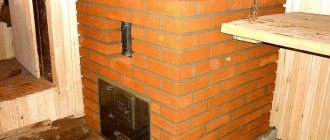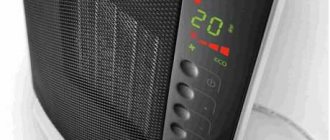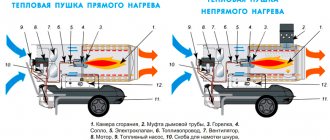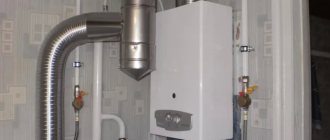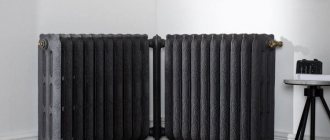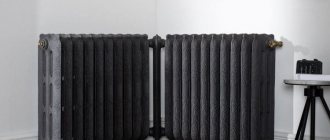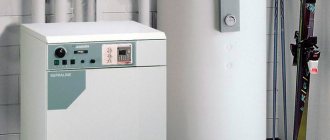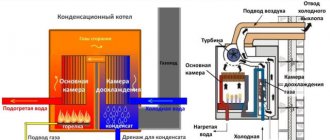During the cold season, many people spend a decent amount of time in unheated garages and outbuildings such as barns.
To make your stay as comfortable as possible, you should consider purchasing equipment such as a heater.
There are quite a lot of similar devices on sale today - they differ from each other in operating principle, overall dimensions, fuel used and a number of other parameters.
To shop for the most suitable equipment, read our review of the best garage heaters.
Rating of the TOP 10 best garage heaters for 2021-2022
| TOP 3 best garage heaters by price/quality for 2021-2022 | ||
| 1 | Ballu BIH-AP4-1.0 | Find out the price |
| 2 | RESANTA TVK-2 | Find out the price |
| 3 | Solar gas GII-2.9 | Find out the price |
| TOP 3 best infrared heaters for the garage | ||
| 1 | Ballu_BIH-LM-15 | Find out the price |
| 2 | Almac IK8 | Find out the price |
| 3 | Ballu BIH-L-3.0 | Find out the price |
| TOP 2 best heat guns for the garage | ||
| 1 | RESANTA TEPK-2000K | Find out the price |
| 2 | Ballu BHDP-20 | Find out the price |
| TOP 2 best oil heaters for garages | ||
| 1 | Electrolux EOH/M-6157 | Find out the price |
| 2 | RESANTA OMM-7N | Find out the price |
Room area
In compact rooms it is enough to install a small device.
It is irrational to buy a heavy-duty heater for a small garage or try to heat a large box with a conventional fan heater.
In compact rooms, it is enough to install an energy-saving infrared device, especially when the owner does not plan to spend a lot of time here.
Which garage heater should you choose?
When choosing a heater, special attention should be paid to the area of the room for which it is purchased:
- For small garages, the best option would be heat fans, which heat up quickly enough and immediately fill the room with warm air. For example, RESANTA TEPK-2000K (2 kW).
- For larger garages (from 20 sq.m.), it is better to purchase an infrared heater. For example, Ballu BIH-L-3.0.
- For large hangars that house multiple vehicles, the Ballu BHDP-20 is the best option.
- If you want to save money, it is better to purchase a gas heater. They are considered more economical and safe. Among those presented is Electrolux EOH/M-6157.
Video description
Advantages and disadvantages of a pyrolysis type solid fuel wood boiler in the video:
Liquid fuel
This category includes heating devices that run on diesel fuel or waste engine oil. For obvious reasons, waste oil is more economical to use than diesel fuel, since it costs much less (sometimes it is available for free). But there's a problem. The oil can be purchased at service stations where the oil in cars is changed. But the service stations themselves use exhaust gas to heat the garage in the winter. Therefore, this type of fuel becomes scarce in winter.
As in the case of solid fuel boilers, there are economical models in the liquid fuel category. These are small-sized units that you can make yourself. Drawings and diagrams are freely available. But it should be noted that liquid fuel boilers, like solid fuel boilers, are fire hazardous equipment. Therefore, representatives of the State Fire Safety Inspectorate may not allow their installation in garages. And this is problem number two.
Furnace in operation Source eurodrova.ru
Basic criteria for choosing a heater for a garage
Oil, gasoline and other flammable liquids are typically stored in the garage. Therefore, when choosing a heater, special attention should be paid to safety.
Oil-based ones are considered the safest, but they take a long time to warm up and heating the room to normal temperature will also take a long time.
Heat guns will do the job much faster. They are equipped with a coil that heats up in a matter of seconds and a fan that immediately begins to distribute heat in the room.
However, such heaters are less safe and require proper location: there should be no flammable substances nearby, and the heaters themselves cannot be covered with anything.
In any case, each heater must have the necessary certificates confirming the safety of the unit.
An important characteristic is the power consumption of the heater; in most of them at maximum operating mode it is 2000 W.
Diesel fuel appliances
If the garage is located far from the house, then its owner should think about buying a diesel heat gun. The operating principle of such an installation is practically no different from electrical appliances, but in this case the air is heated due to fuel combustion.
There are quite a lot of advantages of such heaters:
- quickly warm up the room and automatically maintain the set temperature;
- distribute heat evenly over the entire area;
- allow you to save on heating by using diesel fuel instead of electricity.
Among the disadvantages of such equipment, experts highlight:
- quite high cost of devices;
- the mandatory presence of electricity, which is necessary for the fan to operate;
- an environmental factor, since when diesel fuel is burned, oxygen burns out, and combustion products harmful to health enter the room.
Therefore, in small garages it is recommended to install an indirectly heated diesel gun/boiler, where the combustion chamber is reliably isolated from the convector, and there is a separate outlet for removing harmful substances.
Customer Reviews
Yulia M.
Ballu BIH-AP4-1.0
Careful. Almost invisible under the ceiling. We took it to maintain heat in the living room of a country house. Pleasant sensations. So far we're happy. Disadvantages: The rotating mechanism has a large pitch, it is impossible to adjust it to the desired radius, I’ll say right away that it’s not critical. And I would like more description in the instructions. Comment: In principle, a normal heater, we bought it specifically for the off-season, and immediately bought a regulator for it. Heating is felt throughout the room, not just in spots, as from heating. The only thing is that when I bought it, I couldn’t find information about whether it can be used with stretch ceilings, we are planning to make ceilings, but I would like to clarify. I won’t say anything about power saving, because we’ve been using it for less than a month and the receipt for the electricity hasn’t arrived yet. I am attaching a photo, everything is temporarily connected. We will do repairs and handle everything more carefully.
Alexander P.
RESANTA TVK-2
Advantages: 1. Powerful flow of warm air, heats well. 2. Beautiful design, compact size, and has a carrying handle. 3. There is a rotation mode. 4. Temperature and power can be adjusted. 5. There is protection against capsizing and overheating. Disadvantages: 1. After 2 weeks of operation, clicks appeared that occur when the direction of rotation of the heater changes. It started to get tense. If it doesn’t stop straining or the clicking doesn’t stop, then I’ll take it in for repair) 2. There’s not enough separate button or switch to turn it on and off on the front panel. Turning it on and off using a button would be more convenient than turning the mode switch. 3. A dust filter probably wouldn’t hurt, but it’s not currently in fashion among manufacturers, and maybe it’s not necessary. Comment: Bought as additional heating for home under a computer desk standing by the window. It copes with the task. There was no smell either the first time it was turned on or the subsequent ones. PS: After using it several times, it stopped clicking on its own. Apparently something fell into place)
Alexander Nezvidsky
Solar gas GII-2.9
This heater heats just like a big expensive one, because the area of the ceramics and the gas outlet are the same, the whole difference is in the design and configuration, this heater does not have a gearbox (300-500) rubles and a hose 200 rubles, a regular gas one is suitable (one end We cut off the other one onto the gearbox and pull it onto the heater nozzle, I recommend squeezing it with a clamp for those especially nervous, although everything fits tightly anyway) it’s ready. The CO2 output is minimal and is safe with natural ventilation. I’m heating the garage, in an hour I can heat up 18 m/² to plus 16 with 0 outside the gate. Another 2 kW of wind helps with it in an hour 20 plus at 14 minus outside, it will still depend on the energy efficiency of your room, if you cannot achieve such indicators, think about insulating the room. By consumption: 18 liter composite cylinder with 14 liters of refill, enough for a week when using the heater 5-6 hours a day. Refilling 14 liters costs 430 rubles. A good thing
Valeria D.
Ballu BIH-LM-1.5
Very pleasant warmth, does not dry out the air! Large range of action. Three modes. Metal body. It's on 24/7 and doesn't overheat. Disadvantages: They brought the wrong one, but the S model, it is smaller in size. I'm afraid that its efficiency is less for the same power. It shines at night (but I'm used to it and it doesn't bother me) Short wire. I think it will heat 25 m2 only with good thermal insulation. Comment: I am writing a review specifically for this model (not S), since before ordering I had already purchased such a heater on the market. That’s why I wanted a second one, because I’m very pleased. I use it at my dacha, which is insulated “in places” - at night I just turn it on at 500 watts and direct it towards myself. I sleep under a cotton blanket and feel warm. The room is 12 meters high, if you turn it on at 1000 watts for a couple of hours, it’s hot. It’s convenient that you can just put it next to it and point it at yourself. This will not work with a convector and it heats worse even at a power of 2000 watts
Vladimir Rusakov
Almac IK8
Pros: The design is simple, laconic and at the same time attractive. There is a good choice of colors, for example, I have Almak IK 8 in wenge color, such a pleasant dark brown color, it looks very beautiful against the background of the wooden walls of the attic. There is also white, gold, silver and pine color. Good variety, you can choose one for any room. An interesting fastening in the form of a groove along the entire length and two pendants are inserted into it. Such a simple solution, a very practical heater i.e. you don’t need to measure the distance on the ceiling between the hangers: two hooks in the ceiling and then move the hangers under them and hang the heater. I bought it on the company’s website, on the official one, there are even detailed instructions and all the information on connection and operation. That is, even without seeing the product with your own eyes, you can fully evaluate it. Corresponds to the description. The color also matches. Everyone who comes to visit notices it and mistakes it for a lamp, but if it is turned on, it immediately becomes clear that it is a heater. Disadvantages: The fasteners did not fit into the groove right away. Perhaps there was an influx of paint or something else was in the way. I had to use a flathead screwdriver to pry it out a little there (made in Russia - finish it yourself with a hammer!). There were also minor abrasions on the case, although the packaging was not opened before me. Perhaps it’s the wenge color that gives away all the mistakes. In bright conditions the heaters would not be visible. Comment: There are the same heaters, only of a different size, but the design and everything is generally identical. You can choose one for any quadrature, I recommend taking a closer look at this option if you don’t want to pay dearly, but still need good performance.
Vlad Abramin
Ballu BIH-AP4-1.0
Advantages: 1) Convenience of mounting to the ceiling, and connecting to the wiring, everything is simple and clear. 2) Design Disadvantages: 1) Build quality (but maybe it’s just me, it started clicking, it was solved by disassembling the heater and squeezing some places with pliers); 2) Heating range across the width, and not just underneath. (Example: if you hang it over the bed, lengthwise, but closer to the feet, then after some time the legs will get hot, but the head will freeze; in length, it warms more or less normally, i.e., for example, if the bed is double, then and on the second part of the bed your feet will be quite warm) Comment: In general, it heats the area directly underneath perfectly, it also heats the sides along the length more or less, but not to the sides along the width. Additionally, I connected a Ballu BMT-1 thermostat to the heater. After about a few months, when it was working (heating, when the thermostat does not turn it off), something began to click inside, this does not affect the operation, but now you can’t leave it overnight because it’s loud, judging by the reviews it’s something with the expansion of the metal... In general, this can happen in all models of different companies. In comparison with an oil heater, this is of course better (the power is the same), both in terms of heating and convenience (it doesn’t take up too much space), but not the heating speed, which is slow. Especially if you come in winter and the house is icy, you need to wait at least an hour or two.
Andrey Karpovich
RESANTA TEPK-2000K
Advantages: — Small, takes up little space. — Quite a nice appearance — Lightweight — The cable, although a little short (about 1 meter), is quite enough for my needs — The case does not heat up — Easy to operate — 3 modes Disadvantages: — Lacks a timer — Weak flow Comment: At the time of writing I've been using it for 5 days now, I'm happy with everything. I bought it to heat a loggia (4 sq/m) since it is not insulated. Such an area is heated to a comfortable/room temperature in 15-20 minutes, taking into account that the approximate temperature in the room is +4 - +5. Please note, if you need to heat a room where the temperature is sub-zero or close to zero, then this mini-gun is unlikely to cope with this task, I advise you to take a more powerful model. Initially I didn’t expect much from a budget model, but in the end this model is quite enough for my modest needs
Vova B.
Electrolux EOH/M-6157
Advantages: New technology with accelerated heating. The surface is protected from mechanical damage. It has an interesting appearance, I would say even somewhat futuristic thanks to the round elements, built-in rollers for movement. This is the third year that this radiator has warmed the living room in the evenings and the children's room at night, a very positive impression. The oiler can work for hours without stopping or overheating and I can trust it, thanks to the presence of several safety levels at once. Well-thought-out wheels and a convenient handle allow the radiator to be moved between rooms in a matter of seconds, and in the summer it does not take up much space in the pantry, and the cord is hidden in the body of the radiator itself.
Nikolay S.
RESANTA TVK-2
Advantages: Low price, quickly warms up the room, 90° rotation, ceramic heating elements Disadvantages: The thermostat does not work well: at one adjustment level it can heat for a long time without turning off, or it may not turn on when it gets noticeably cold, as if there are tolerances of several degrees; The rotation around the axis does not stop when the mode is switched to the zero position, only disconnecting from the network Comment: As a heater - an excellent product: it heats quickly, consumes little, there was no smell As a climate control device - it is unlikely to be useful, it heats for a long time until it gets hot ( 24-25* at the heater level), then for a long time it does not warm up to noticeable coolness (20-21*)
Alexander S.
Ballu BHDP-20
Pros: I liked everything. The build quality is the size and most importantly how it works. I have several garages and it can be easily moved from one to another by the handle. The most important thing is that it works completely automatically. I set the desired temperature with the regulator and that’s it. It will turn on itself and turn off when the set temperature is reached. As soon as the temperature drops below the set one, it turns on again and so on until you turn it off or the diesel fuel runs out. Comment: When you turn it on in the garage, it is better to stick it out the door because the first exhaust will stink a little. Then it works in the room with virtually no odor. A 5-liter bottle is enough for a day to maintain the operating temperature in three garages - But not a whole day of work, but as needed .
Valentin N.
RESANTA OMM-7N
Advantages: Size, low power. Disadvantages: Lack of a shutdown button (there is one in the photo, in fact I don’t have one, only a light bulb, but they didn’t show it on the packaging either) Comment: Compact low-power oil heater, just what I was looking for for a balcony. Actual size 30x15x37 cm LxWxH No rollers, for me it doesn’t matter because... It is lightweight due to its compactness and has a handle for carrying. The power is enough to heat a small room (for me it’s a balcony) and at the same time not to overload the electrical wiring. I think it will be very suitable for those who were looking for a heater under the table, etc.
Leonard T.
Ballu BIH-L-3.0
Advantages: 1. The summer veranda is heated all over evenly, this is facilitated by the reflector located behind the heating lamp. 2. During use, it has not lost its attractive appearance: the steel case has not been deformed; The chrome grille, which protects against accidental contact with the heating element, has not rusted. Disadvantages: I had to go shopping to find a special telescopic tripod for installing the heater, because it was not included in the package. Comment: On the open veranda of my cafe you can not only have a tasty snack, but also warm up in cold weather; for this I installed a modern infrared heater, which gives visitors warmth from the moment it is turned on. I set the heating power depending on the air temperature to make it comfortable.
Types of electric heaters
Electric heaters can use different methods of heat transfer in their operation. Based on this feature, there are several types:
- Convective. This category combines electric convectors, fan heaters, air heaters.
- Radiating. This can include heat-emitting mirrors and IR panels.
- Convective-radiative, combined models. This group includes the most common type - oil radiators.
In order to make the right choice and find the most economical heat source for your home, you need to compare the technical parameters of all categories.
Convective
Electric convectors
The operation of such models is based on the phenomenon of convection. The work looks like this. The fan draws in cold air and passes it through a heating element system. The heated air goes out, rising to the top. The constant movement of air flows in the room ensures uniform heating of the room.
Regardless of the specific type and model, the convector is able to quickly warm up the room. It is indispensable in country houses, where the owners appear from time to time, and the installation of a complex heating network is simply impractical. Convectors are economical devices, but it is still not always advisable to install them as a constant source of heat. The simplest cheap models remain a fire hazard. Convectors with complex emergency shutdown, protection, and safety systems belong to more expensive price categories. Power consumption is quite high. The main disadvantage is the burning of oxygen by heating elements.
Infrared
Such heaters are modern, technically sophisticated devices. They have a more complex operating principle than convectors. The main difference is the use of infrared radiation. Such heat penetrates deeply into surrounding objects, and from them the air is heated. In fact, the operation of infrared heaters can be compared to the sun's rays. Not a single one, even the most modern and advanced convector, can compare with them in efficiency.
IR panel heater
It is impossible not to note the positive effect of infrared rays on humans. Even in a cold room a person will feel warm. If the convector warms the room mainly in the upper part, then the IR heater will provide uniform heating in the full sense of the word.
IR models are almost completely free of the disadvantages that convectors have.
The only and main drawback is significant power consumption. IR devices can hardly be called economical, but electric heaters of this type have the ability to program different operating modes, allowing the device to automatically turn off if additional heating is not necessary. These features help reduce energy consumption.
Combined
Combination models are the cheapest, so they are the most popular on the market. They are absolutely not suitable as the main source of heat. It is worth choosing a combination heater if you plan to use it for a short period of time to slightly raise the air temperature.
In terms of the method of heat transfer, they resemble a convector. The oil poured into the radiator heats up to a predetermined temperature, and the metal surface of the heater begins to release the resulting heat. Just like convectors, combined models can have a built-in fan and turbocharging function. Such elements allow you to increase the rate of heating of the room, bringing the parameter at least a little closer to the performance of infrared devices. Among the shortcomings, one cannot fail to note the significant dimensions, massiveness, and heavy weight.
Video description
In this video we will look at issues related to air heating:
The fifth position, which is sometimes not taken into account when choosing garage heating. This is the need for energy storage. Firewood, coal and other types of solid fuel, as well as waste, must be stored somewhere. In addition, the storage location will be subject to strict fire safety requirements. In this regard, electricity and gas are ideal. So we will have to think through this side of the issue too.
Gas heat generators
As equipment for heating a garage, gas heaters are somewhat inferior in popularity to diesel heaters, since connecting a garage building to a natural gas pipeline requires developing a project, and using bottled propane or butane is much more expensive. However, in regions with an average length of the heating season, gas heaters are used in garage buildings quite often.
Heating a garage with a gas heater using bottled propane
Gas heaters are divided into infrared and convection heaters. In both types of units, heat is generated by burning gas, but the devices differ in the way they transfer thermal energy.
From the perspective of ease of use in the garage, let’s look at examples of compact units.
Infrared gas heater BALLU BIGH-3 —
An example of a modern energy-saving heating device with the functionality and efficiency required for a garage.
The device is connected through a reducer to a cylinder with propane or butane and sent to the current zone.
After igniting the burner, the ceramic panel, which emits infrared waves, is heated. Infrared radiation heats the surfaces of objects located in the path of propagation, and then the heated interior releases heat into the air in the room.
*
The model is convenient for local directed heating of areas and objects, which is convenient when performing car repairs in the garage. In addition, the adjustable stand allows you to direct the radiation upward and use the device to heat water or cook food.
Main characteristics:
- ignition - manual;
- fuel – propane, butane;
- heat release power – 3 kW (max);
- heated area – up to 30 m2;
- fuel consumption – up to 200 ml/h;
- heater dimensions – 22.5x21.5x22.1 cm;
- weight when filled is 2.2 kg.
Advantages of the model:
- compactness;
- efficiency;
- high-quality paint and varnish coating of the body;
- Class A ceramic emitter of protected design.
Important! Sellers of BALLU BIGH-3 present the heating panel as not subject to deformation from contact with water, but the degree of this resistance is uncertain, therefore, in a garage where car washing is practiced, this IR heater should not come into contact with moisture.
Gas convectors operate on a different principle - the gas burning in the device heats a metal heat exchanger plate, which, in contact with the room air, initiates the formation of convective flows. Gas combustion occurs in the unit body, isolated from the heated volume, and combustion products are discharged outside through a coaxial or conventional chimney.
Due to the removal of combustion products to the street, heat loss when heating with such a device is significant, therefore, to ensure sufficient heat transfer, the heat exchangers of convectors have a much larger area than the heating panels of infrared gas heaters.
Cylinder-powered convection heater
The operation of gas convectors requires significant gas consumption, so they are rarely used for heating garages. In addition, these heaters come into operation slowly, but in a garage the effect of the unit should be quick.
Important! When equipping a garage with a gas convector with an open combustion chamber, the room must be provided with ventilation with three air changes within an hour.
Use of general heating
The ideal situation is when the garage is located next to a private house or a public heating pipe. You can route the heating main into it. In the case of a city, everything is done through the appropriate services. In relation to home, it’s simpler - you need several radiators, connecting pipes and insulation for laying a heating main along the street. In the case of a private option, the central hot water supply line from the boiler is disconnected, into which an additional heating branch is built, as if extending it. Below are two options for inserting into the heating network of a house, depending on its type.
When connecting a garage to a citywide network, the connection is made by tapping (without breaking it!) into the hot water supply and return line. In general, it is better to entrust such a procedure for a municipal heating system to specialized organizations. It will not be much more expensive than the design of the insertion project itself, carrying out work on it and other nuances of execution.
Making a stand
The stand is made from a metal corner or profile. Dimensions are set based on the overall size of the heater. To make it you will need a welding machine and an electric grinder – “grinder”. From a corner or profile we cut the elements of the future stand. Its shape is also arbitrary. It is only necessary to take into account such a point as the ease of disassembling it. It is quite possible that it will be necessary to disassemble the heater. For example, in the spring, when it is no longer needed.
Before you start making the stand, you need to draw its diagram, determine the dimensions and prepare the blanks.
To do this, use a grinder to carefully cut the required number of corners and sand their edges. All that remains is to “cook” the pieces cut according to the pattern. After welding, the seams are cleaned and the stand is prepared for painting.
